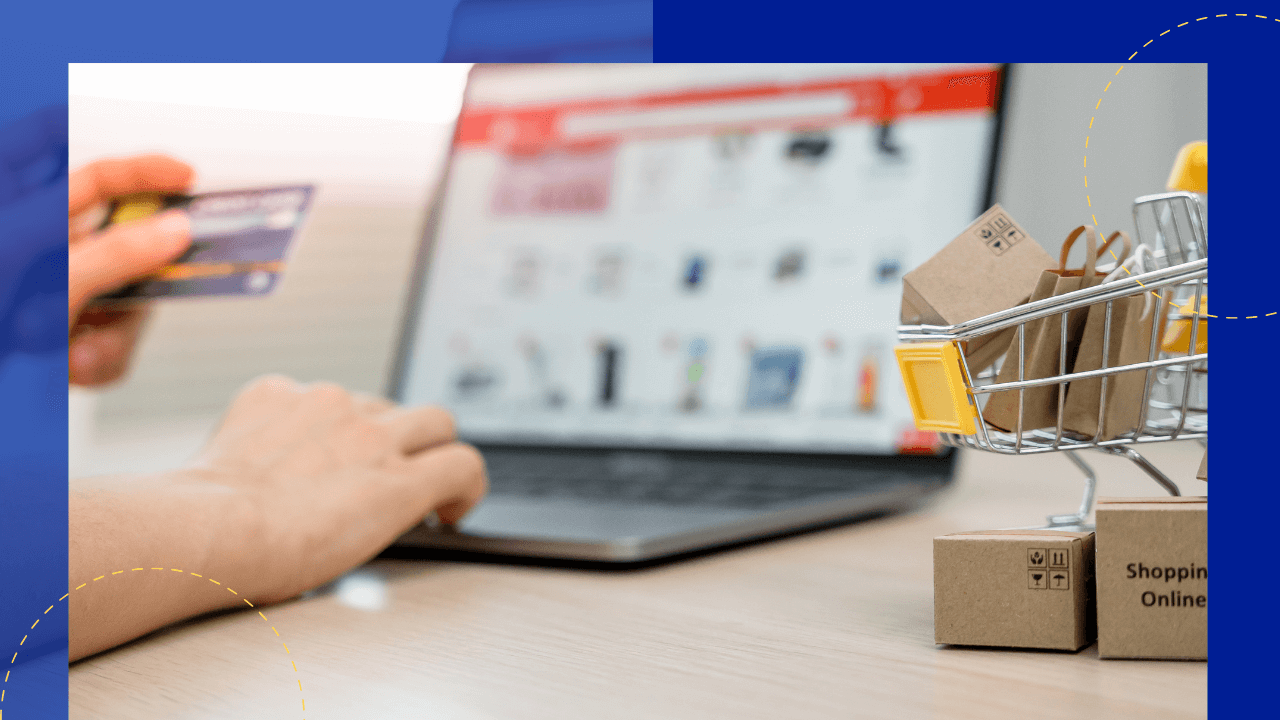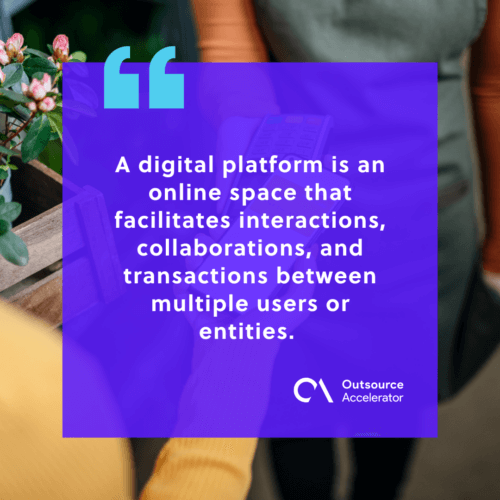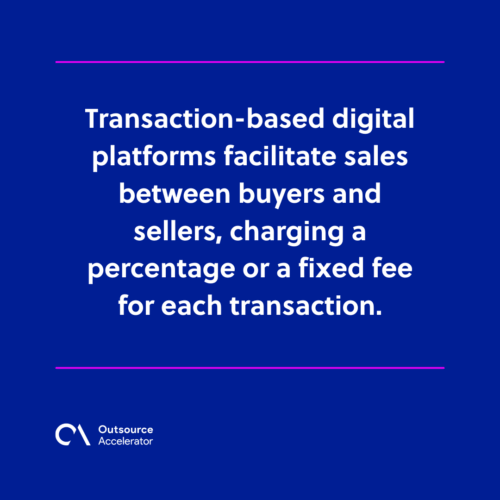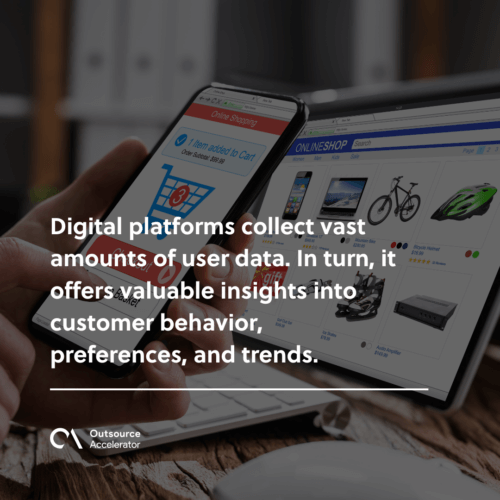Digital platform decoded: Revolutionizing business interactions

Businesses constantly seek ways to innovate and expand their reach. Nowadays, digitalization has become the norm, so brands are adopting digital platforms.
A digital platform significantly transforms how companies interact with customers, suppliers, and partners. This virtual space has become the backbone of modern business operations, enabling seamless communication, data exchange, and transactions.
Let’s delve into the world of digital platforms. We’ll explore the types, monetization models, key elements, and the benefits they offer.
Whether you’re a budding entrepreneur or a business professional, understanding the power and potential of a digital platform is essential for staying ahead of the curve.
What is a digital platform?
A digital platform is an online space that facilitates interactions, collaborations, and transactions between multiple users or entities. It serves as a virtual ecosystem where people can connect, share information, and engage in various activities.
Digital platforms are built upon cutting-edge technology and are accessible through the internet.
They have become instrumental in reshaping industries, disrupting traditional business models, and fostering innovation.

Types of digital platforms
Digital platforms come in various forms and serve different purposes. Let’s explore the different types of online spaces:
Social media platforms
Social media platforms have revolutionized how people communicate and connect worldwide. These sites allow users to create profiles, share content, and engage with others.
Businesses leverage social media to build their brand presence, engage with their target audience, and run targeted advertising campaigns.
Prominent social media platforms include Facebook, Twitter, Instagram, LinkedIn, and TikTok.
Data from Search Engine Journal reveals that there are 4.8 billion social media users globally. They represent 59.9% of the worldwide population and 92.7% of all internet users.
Knowledge platforms
Knowledge platforms are designed to share and disseminate information, expertise, and educational content.
These channels host a vast array of resources, including articles, tutorials, videos, and webinars. They cater to various niches, from academic subjects to professional skills development.
Some popular knowledge platforms include Wikipedia, Coursera, Khan Academy, and Udemy.
Media sharing platforms
Media sharing platforms allow users to upload, view, and share multimedia content. This content includes images, videos, and audio files.
These spaces serve as a hub for creative expression and entertainment. YouTube, Vimeo, Flickr, and SoundCloud are notable examples of media sharing platforms.
Service-oriented platforms
Service-oriented platforms connect service providers with consumers, offering a range of services.
These online platforms streamline the process of finding and hiring service providers. They provide convenience for both customers and providers.
Examples of service-oriented platforms include Uber, Airbnb, Fiverr, and Upwork.
Monetization models for digital platforms
A digital platform needs sustainable revenue models to thrive. Here are some common monetization models:
Advertising
Sites like Facebook and Google generate significant revenue through targeted advertising. They leverage user data and offer targeted promotional opportunities.
These digital platforms can create value for businesses looking to reach their desired audience.
Subscription-based
Websites like Netflix and LinkedIn offer premium features or exclusive content behind a subscription paywall. This model ensures a consistent revenue stream while providing additional value to subscribers.
Transaction-based
Digital platforms like Amazon and eBay rely on transaction fees. They facilitate sales between buyers and sellers, charging a percentage or a fixed fee for each transaction.

Combination
Many platforms combine different monetization models. For example, Spotify offers a freemium model with ads for free users. For premium users, the application has a subscription plan without ads.
Key elements of a digital platform
A successful digital platform has some key elements that contribute to its effectiveness:
- User base. A digital platform can create network effects and reinforce its value by attracting and retaining a strong user base.
- User experience (UX). A seamless and intuitive user interface (UI) is essential to engage and retain users. Digital platforms prioritizing UX invest in responsive design, personalization, and ease of use.
- Technology infrastructure. A digital platform’s underlying technology infrastructure is crucial for its performance and scalability. Robust systems and infrastructure can handle increasing user loads and ensure a smooth UX.
- Data and analytics. With data, online platforms can gain insights into user behavior, preferences, and trends. This information enables personalized experiences and targeted offerings.
- Security and privacy. Digital platforms often handle sensitive user data, making security and privacy paramount concerns. Implementing robust security measures and adhering to data protection regulations instill user trust and confidence.
- Scalability and performance. As the user base grows, a digital platform must be capable of handling increased traffic and usage. Scalability allows the medium to adapt to higher demands without compromising performance.
- Integration and interoperability. Integrating with other relevant channels and systems expands the digital platform’s capabilities. Interoperability allows seamless data exchange and collaboration between different applications.
Benefits of a digital platform
Digital platforms offer a host of benefits to businesses and individuals alike. Here are some notable advantages:
Expanded reach
A digital platform can access a global audience. It allows businesses to expand their reach beyond traditional boundaries.
This broad exposure can lead to increased brand awareness and customer acquisition.
Efficient matchmaking
Online spaces bring together buyers, sellers, service providers, and customers. They facilitate efficient and targeted connections.
This matchmaking capability streamlines processes and reduces friction, making transactions smoother.
Cost savings
Companies can reduce infrastructure and operational costs using a digital platform. For example, an enterprise can avoid building a physical store by selling products through an e-commerce platform.
Innovation and collaboration
Online platforms foster innovation and collaboration. It does so by creating an environment that encourages information sharing and co-creation.
This leads to new ideas, partnerships, and opportunities for growth.
Data-driven insights
Digital platforms collect vast amounts of user data. In turn, it offers valuable insights into customer behavior, preferences, and trends.
Analyzing this data empowers organizations to make informed decisions. It also allows them to tailor their offerings to meet customer needs.

Streamlined transactions
With seamless online transactions, a digital platform facilitates efficient and convenient purchasing processes. This benefits customers, streamlines supply chains, and reduces operational costs.
Creating a digital platform
Building a successful digital platform requires careful planning and execution. Here are important steps to keep in mind:
- Identify the target audience. Knowing the target audience’s needs and preferences helps make a digital platform that resonates with its users.
- Define the platform’s purpose. Clearly articulate the platform’s purpose. It can be facilitating networking, providing knowledge, or offering services.
- Design an intuitive interface. A user-friendly interface ensures an easily navigated and interactive digital platform.
- Develop robust backend infrastructure. The platform’s backend must be reliable, scalable, and secure to efficiently handle user data and traffic.
- Test and iterate. Thoroughly test the digital platform for usability and functionality.
- Launch and promote. Once the platform is ready, launch it to the target audience. Implement marketing strategies to generate awareness and attract users.







 Independent
Independent




